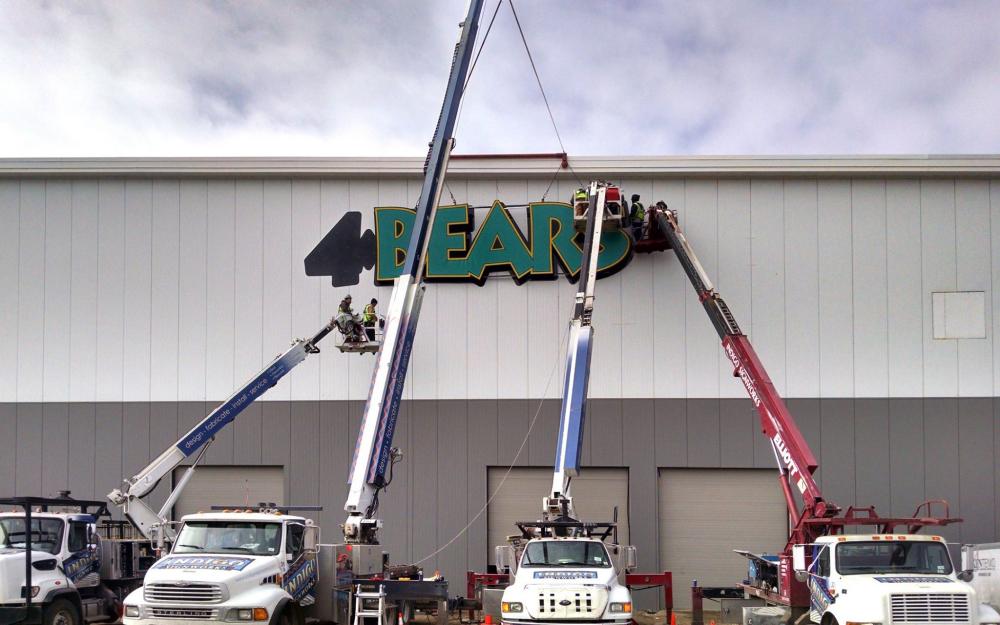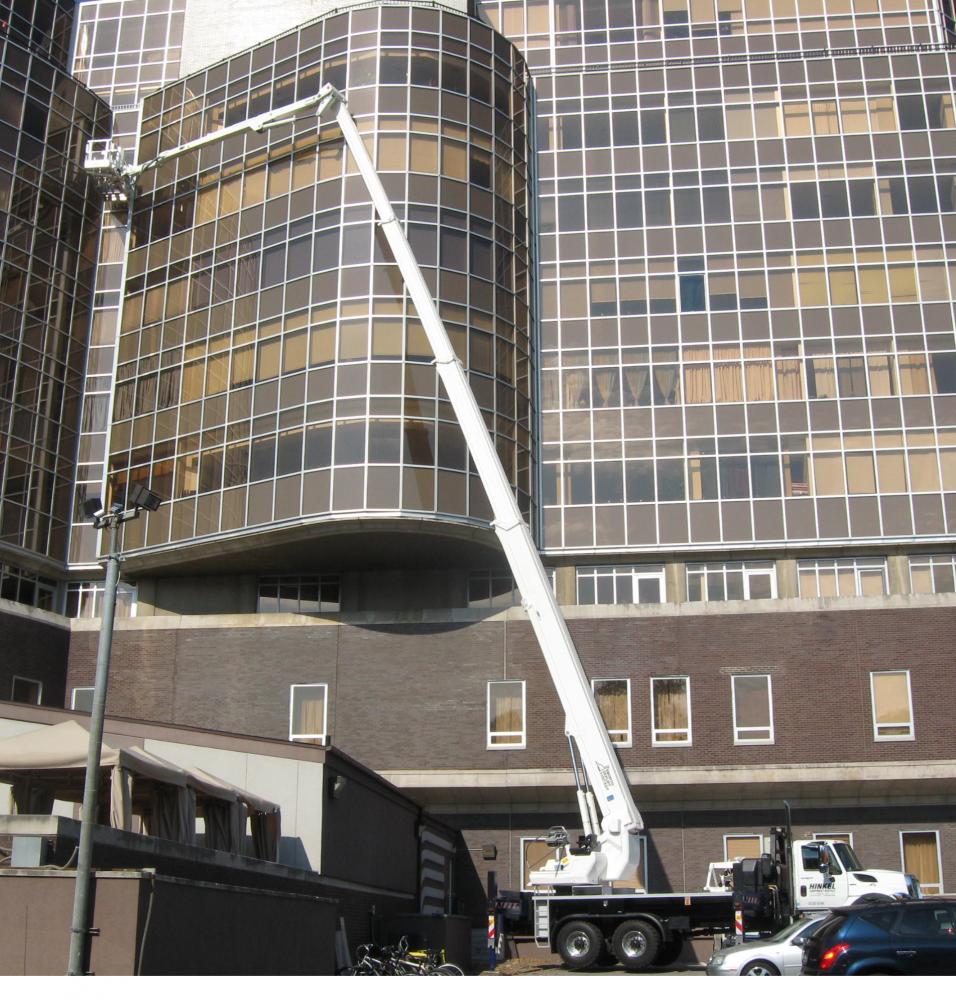


In the United States, truck-mounted aerials are often associated with the electrical utility industry. Larger models help build and maintain high-voltage transmission lines that stretch from tower to tower hundreds of feet above the countryside, and smaller models are a familiar sight installing and maintaining the distribution lines that carry vital electricity to homes, commercial buildings, factories, and other users.
But a host of other industries—ranging from telecommunications and tree care, to commercial and transportation sign work, lighting installation and maintenance, window installation and cleaning, building inspection and maintenance, bridge inspection, and railroad work—also rely on truck-mounted lifts to complete their work efficiently and safely.
Several of the manufacturers that make truck-mounted aerials for electrical utility use also manufacture models designed for non-utility applications. And in some cases, the same models serve both utility and non-utility users. For example, tree-care workers who trim branches away from power lines can use an insulated lift as surely as the utility crews who work directly on the live wires.
Major manufacturers who make truck-mounted aerials in the United States include Altec, Elliott Equipment, Manitex, Terex Utilities, and Time Manufacturing (Versalift). They are joined in the market by three principal European manufacturers: Finland’s Bronto Skylift, Austria’s Palfinger, and Italy’s Socage.
Bronto Skylift’s U.S. operations are headquartered in Orlando, Fla., and Palfinger’s North American operations are centered in Niagara Falls, Ontario, with related companies in Tiffin, Ohio; Council Bluffs, Iowa; and Oklahoma City, Okla. Socage does not have an operation in the United States, but one of its key distributors is Truck Utilities in St. Paul, Minn.
Varying market views
The state of the market for truck-mounted aerials used outside of electrical utility work seems to depend on whom you talk to.
For the most part, and not surprisingly, smaller lifts with platform heights of, say, 35 to 60 ft. seem to be seeing a stronger market than the 120- to 300-ft. models—although not it all cases.
Scott Sasser, sales and product manager for Palfinger’s aerial lifts sees the market for big truck mounts as being strong, and he expects it to grow through the short and medium term.
Amber Kaiser, Time Manufacturing’s marketing manager, agrees. “The market is strong, and should continue to be for the rest of the year,” she says.
On the other hand, Paul Capeder, crane sales manager for Truck Utilities, which has its own rental fleet and also sells Socage and Manitex products, says that he sees the current market as slow but developing.
David Phillips, manager of global business development for Elliott Equipment Company, agrees with Capeder. “We see the industry being flat to slightly up for the balance of the year,” he says. Phillips sees the key forces influencing the market for truck-mounted aerials as being increasing rates of employment, lower commodityprices, deleveraging of consumer balance sheets, historically low interest rates, a shift to greener forms of energy, and customer cautiousness pending the outcome of this November’s national elections.
Growing need for safety, efficiencies
Major trends among truck-mounted aerial lifts include further increasing safety, putting more capacity and reach on smaller chassis, and simplifying setup and operation.
“The market continues to look for ways to make work safer and more efficient,” says Elliott’s Phillips.
The industry is driving changes in safety requirements, as evidenced by the 2015 revision of the ANSI A92.2 standards for vehicle-mounted aerial devices, says Dustin Yost, a market manager for Altec. “The most significant trend, I think, is the development of additional safety features,” he adds. “The coming years will provide some great opportunities to implement new technology in the name of operator safety.”
Because the user generally has a job to perform other than just operating the lift, Truck Utilities’ Capeder says manufacturers continually make the equipment more foolproof. “The main onus for safe operation still rests with the operator, but more built-in safeguards give a bit more back-up,” he adds.
One example of those safeguards is the ultrasonic anti-collision system that Bronto Skylift now offers, according to Steve Starling, Bronto’s U.S. sales manager.
Putting more reach into a smaller package is another trend. “Customers want good reach on a small chassis,” says Capeder.
According to Terry Van Conant, marketing communications coordinator for Terex Utilities, users of truck-mounted aerial lifts and digger derricks continue to ask for reduced overall gross vehicle weight in order to increase payload and improve fuel efficiency.
For smaller lifts, the weight savings can translate into being able to mount the aerial on a smaller truck. In addition to the increased payload and fuel efficiency mentioned above, the benefits include using a vehicle that costs less to buy, eliminating the need for the driver to have a commercial driver’s license (CDL), and minimizing insurance costs. For larger lifts, maximizing the efficiency of the chassis lets the rig fit into spaces that it otherwise couldn’t, and also minimizes overall weight for increased fuel efficiency.
A growing trend among telecom, telephone, and cable companies is to use battery-powered lifts that are quiet and minimize truck idling, says Time Manufacturing’s Kaiser.
Non-utility users
One company that uses truck-mounted aerial lifts in and out of utility work is Hinkel Equipment Rental Associates, Huntingdon Valley, Pa. Headquartered in metropolitan Philadelphia, Hinkel operates a fleet of about 25 large Bronto Skylift aerials ranging in height from 111 to 200 ft. The units go out on rent all across the country, primarily to electrical utilities or contractors that work for them. But owner Mark Hinkel says that some rentals go to companies involved in building inspection, bridge inspection, petrochemical plant maintenance, and even movie and television work.
“The current market for non-utility work is so-so right now, but it’s coming along,” says Hinkel. “For many quick jobs, a truck-mounted aerial can be in, done, and out more cost effectively than a self-propelled lift. But using truck-mounted aerials in general applications is still much more popular in Europe than here.”
FairWind Renewable Energy Services, Oklahoma City, Okla., primarily uses its fleet of 230-ft. and 338-ft. Palfinger truck-mounted aerial lifts to service wind turbines. But the company has also quoted work in the movie industry. “Our lifts are tall, set up quickly, and have the capacity to carry a camera, lights, and crew,” says Brett Bain, executive managing director.
One group that finds truck-mounted lifts absolutely vital is sign contractors, who count on their aerial lifts for installing,maintaining, and removing their products.
“We absolutely rely on our truck-mounted aerials every day,” says Bernie Dardis, CEO of Indigo Signworks, which is headquartered in Fargo, N.D., and has five other branches in North Dakota, South Dakota, and Minnesota. The company’s main focus is on-premises signage.
Indigo operates a fleet that includes more than 30 boom trucks and more than 40 truck-mounted aerial lifts, mostly from Elliott, but with some Manitex units, too. The trucks that have aerials with platform heights from 60 to 90 ft. are operated by two-person teams.
“For sign trucks, smaller is better,” says Dardis. “The smallest truck you can get a 90-ft. lift on is the largest we generally need. When a job demands equipment that can reach higher or lift more, we rent.”
Dardis says that manufacturers of truck-mounted aerials for the sign industry have done a great job of listening to customers. “The manufacturers have been really responsive,” he says. “Over the past 15 years, they have put more emphasis on aerials for the sign industry. They’ve added features like extension bars on the bucket to carry lighter signs along with the crew, faster outriggers to shorten setup time, better controls, and better in-basket amenities like water, air, and welding leads that make work more efficient.”
Dardis’ equipment acquisition strategy helps his company manage costs. Although he buys some new truck-mounted aerials, he generally looks for used equipment that’s in excellent condition. “Sign companies are generally small businesses, so the cost of acquiring equipment can be a challenge,” he says. His answer: Find one- to two-year-old equipment that’s in great shape and has just come off of lease, then purchase it under a lease-to-buy arrangement.
John Lewis, president of Lewis Sign Builders, Buda, Texas, says his company relies heavily on its fleet of eight truck-mounted aerials as it installs and services commercial signs within about 200 miles of Austin, Texas. Lewis Sign’s fleet includes three Elliott L60 and one G85 sign cranes, as well as a 26-ton Manitex with 101-ft. reach and a two-person platform.
“Truck-mounted aerials are just as essential to a sign company as a scalpel is to a surgeon. We wouldn’t be in business without them,” says Lewis.
His list of most important features includes safety controls in the basket, a 110V outlet, welding leads, 360° rotation, and a jib winch. “Eighty percent of the signs we handle weigh 300 to 500 lbs., so the winch is really helpful,” he says.
One equipment trend he’s not excited about: “Most truck manufacturers have gone from standard transmissions to automatics, which use about 20% more fuel,” he says.
Newest rigs
Here’s a brief rundown of the latest developments from manufacturers of truck-mounted aerial lifts.
• Altec’s two most recent launches include the AN67-100, an articulating overcenter aerial device with a total platform height of 100 ft., and the AC40-152S, a dual-rated rig with both an aerial and a crane mode of operation and 217-ft. platform height.
• Bronto launched its new Plus 4 control system at the ICUEE trade show last October, and has introduced its SkyliftFleet.com remote diagnostics and equipment management system.
• Elliott recently launched its E190 E-line truck-mounted aerial work platform, which features a high-capacity main winch and up to 196 ft. of platform height on a telescoping non-articulating boom. It has also added an optional 2,000-lb.-capacity main winch to its M43 HiReach and a 500-lb.-capacity platform jib winch to its L60 HiReach.
• Palfinger will soon import the first P900 to be seen in North America. The P900 is just 53-ft. long when stowed, yet delivers 288-ft. platform height, 106-ft. horizontal reach, 26-ft. below-grade reach, and 1,124-lb. platform capacity.
• Manitex used last year’s ICUEE to unveil its TC400/450/45142, a new dual-rated boom truck that can work as a crane or as an ANSI A92.2-compliant aerial lift. The TC45142 rolled out at ICUEE was equipped with a 142-ft. boom, but the company will also offer the same machine with a 128-ft. boom for taxi-crane operations.
• Socage’s new ForSte 94TW is a truck-mounted telescopic aerial lift with 87-ft. platform height and 1,320-lb. capacity.
• Terex Utilities’ latest innovations are the cobra-style jib for its Hi-Ranger TL and LTM aerial devices, and the insulating, retractable, 4-ft. fiberglass boom section.
• Time Manufacturing has boosted the platform capacity of its VST 5000, 5500, and 6000 articulated telescopic lifts to 750 lbs. The manufacturer has also introduced the VST models 6300, 6600, and 7000, which offer more height and capacity and can be installed on a single-rear-axle truck.